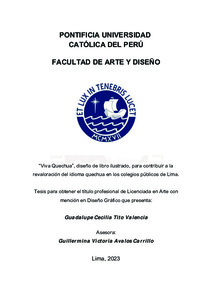| dc.contributor.advisor | Avalos Carrillo, Guillermina Victoria | |
| dc.contributor.author | Tito Valencia, Guadalupe Cecilia | |
| dc.date.accessioned | 2023-06-20T02:48:58Z | |
| dc.date.available | 2023-06-20T02:48:58Z | |
| dc.date.created | 2023 | |
| dc.date.issued | 2023-06-19 | |
| dc.identifier.uri | http://hdl.handle.net/20.500.12404/25230 | |
| dc.description.abstract | La lengua es uno de los signos más distintivos de la cultura y la identidad. El quechua es una
de las lenguas nativas más habladas en el Perú, sin embargo, ha sido relegada tanto a nivel
histórico como social. A nivel etnográfico los quechua hablantes han sido desprovistos de
material educativo en comparación con sus pares hispanohablantes y esto trae como
consecuencia una brecha educativa y económica muy marcada. El quechua sigue siendo una
lengua vigente ya que, según el censo de 2017, 3.799.780 de habitantes tienen al quechua como
lengua materna, lo que representa el 13,6% de la población total.
Esta investigación plantea una revisión general del contexto actual de la lengua quechua, desde
su sintaxis lingüística hasta las políticas de Educación Intercultural planteadas por el MINEDU
y propone el proyecto editorial “Viva Quechua” donde se usa cuentos universales clásicos para
enseñar quechua a los niños de la costa y castellano a los niños de la sierra. Viva Quechua no
sólo ilustra y traduce cuentos clásicos, sino que propone una serie de interacciones que permiten
vivir una experiencia lúdica incorporando las tecnologías digitales a una estética basada en
tintes andinos.
La presente tesis se estructura en cuatro capítulos. En el primer capítulo se define el problema,
la pregunta de investigación, los objetivos de la investigación y la hipótesis. El segundo capítulo
se centra en el desarrollo del marco teórico. En el tercer capítulo se abordará la metodología
usada tanto en la investigación como en el proyecto propuesto. En el capítulo cuatro se
desarrolla la propuesta de diseño desde su conceptualización hasta el diseño de la
comunicación. | es_ES |
| dc.description.abstract | Language is one of the most distinctive signs of culture and identity. Quechua is one of the most
widely spoken native languages in Peru. However, it has been relegated both historically and
socially. At the ethnographic level, Quechua speakers have been devoid of educational material
compared to their Spanish-speaking peers, resulting in a very marked educational and economic
gap. Despite popular perception, Quechua is still a current language since, according to the
2017 census, 3,799,780 inhabitants have Quechua as their mother tongue, representing 13.6%
of the total population.
This research proposes to review everything concerning the Quechua language, from its
linguistic syntax to the Intercultural Education policies proposed by MINEDU.
Proposes the editorial project "Viva Quechua" that uses classic universal tales to teach Quechua
to the children of the coast and Spanish to the children of the mountains. “Viva Quechua” not
only illustrates and translates classic tales but it proposes a series of interactions that allow to
live a playful experience incorporating digital technologies to an aesthetic based on natural and
Andean dyes.
This thesis is structured in four chapters. The first chapter defines the problem, the research
question, the research objectives, and the hypothesis. The second chapter focuses on the
development of the theoretical framework. The third chapter will address the methodology used
both in the research and in the proposed project. Finally, in chapter four, the design proposal is
developed from its conceptualization to the communication design. | es_ES |
| dc.language.iso | spa | es_ES |
| dc.publisher | Pontificia Universidad Católica del Perú | es_ES |
| dc.rights | info:eu-repo/semantics/openAccess | es_ES |
| dc.rights.uri | http://creativecommons.org/licenses/by-nc-nd/2.5/pe/ | * |
| dc.subject | Libros--Diseño | es_ES |
| dc.subject | Quechua--Estudio y enseñanza | es_ES |
| dc.subject | Quechua--Libros de lectura | es_ES |
| dc.subject | Publicidad | es_ES |
| dc.subject | Interculturalidad | es_ES |
| dc.title | "Viva Quechua”, diseño de libro ilustrado, para contribuir a la revaloración del idioma quechua en los colegios públicos de Lima | es_ES |
| dc.type | info:eu-repo/semantics/bachelorThesis | es_ES |
| thesis.degree.name | Licenciado en Arte con mención en Diseño Gráfico | es_ES |
| thesis.degree.level | Título Profesional | es_ES |
| thesis.degree.grantor | Pontificia Universidad Católica del Perú. Facultad de Arte y Diseño | es_ES |
| thesis.degree.discipline | Arte con mención en Diseño Gráfico | es_ES |
| renati.advisor.dni | 07897880 | |
| renati.advisor.orcid | https://orcid.org/0000-0001-6740-0752 | es_ES |
| renati.author.dni | 71336086 | |
| renati.discipline | 211176 | es_ES |
| renati.juror | Ayuni Chea, Cheistian | es_ES |
| renati.juror | Avalos Carrillo, Guillermina Victoria | es_ES |
| renati.juror | Manrique Villavicencio, Lileya | es_ES |
| renati.level | https://purl.org/pe-repo/renati/level#tituloProfesional | es_ES |
| renati.type | https://purl.org/pe-repo/renati/type#tesis | es_ES |
| dc.publisher.country | PE | es_ES |
| dc.subject.ocde | https://purl.org/pe-repo/ocde/ford#6.04.09 | es_ES |







